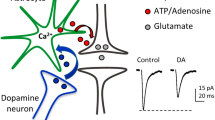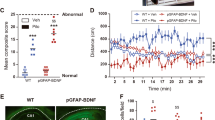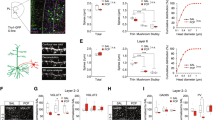Abstract
Interest in astroglial cells is rising due to recent findings supporting dynamic neuron–astrocyte interactions. There is increasing evidence of astrocytic dysfunction in several brain disorders such as depression, schizophrenia or bipolar disorder; importantly these pathologies are characterized by the involvement of the prefrontal cortex and by significant cognitive impairments. Here, to model astrocyte pathology, we injected animals with the astrocyte specific toxin L-α-aminoadipate (L-AA) in the medial prefrontal cortex (mPFC); a behavioral and structural characterization two and six days after the injection was performed. Behavioral data shows that the astrocyte pathology in the mPFC affects the attentional set-shifting, the working memory and the reversal learning functions. Histological analysis of brain sections of the L-AA-injected animals revealed a pronounced loss of astrocytes in the targeted region. Interestingly, analysis of neurons in the lesion sites showed a progressive neuronal loss that was accompanied with dendritic atrophy in the surviving neurons. These results suggest that the L-AA-induced astrocytic loss in the mPFC triggers subsequent neuronal damage leading to cognitive impairment in tasks depending on the integrity of this brain region. These findings are of relevance to better understand the pathophysiological mechanisms underlying disorders that involve astrocytic loss/dysfunction in the PFC.
This is a preview of subscription content, access via your institution
Access options
Subscribe to this journal
Receive 12 print issues and online access
$259.00 per year
only $21.58 per issue
Buy this article
- Purchase on Springer Link
- Instant access to full article PDF
Prices may be subject to local taxes which are calculated during checkout





Similar content being viewed by others

References
Wang D, Bordey A . The astrocyte odyssey. Prog Neurobiol 2008; 86: 342–367.
Parpura V, Heneka MT, Montana V, Oliet SHR, Schousboe A, Haydon PG et al. Glial cells in (patho)physiology. J Neurochem 2012; 121: 4–27.
Kimelberg HK . Supportive or information-processing functions of the mature protoplasmic astrocyte in the mammalian CNS? A critical appraisal. Neuron Glia Biol 2007; 3: 181–189.
Parpura V, Verkhratsky A . Homeostatic function of astrocytes: Ca2+ and Na+ signalling. Transl Neurosci 2012; 3: 334–344.
Araque A, Parpura V, Sanzgiri RP, Haydon PG . Tripartite synapses: glia, the unacknowledged partner. Trends Neurosci 1999; 22: 208–215.
Newman EA . New roles for astrocytes: Regulation of synaptic transmission. Trends Neurosci 2003; 26: 536–542.
Perea G, Navarrete M, Araque A . Tripartite synapses: astrocytes process and control synaptic information. Trends Neurosci 2009; 32: 421–431.
Yang Y, Ge W, Chen Y, Zhang Z, Shen W, Wu C et al. Contribution of astrocytes to hippocampal long-term potentiation through release of D-serine. Proc Natl Acad Sci USA 2003; 100: 15194–15199.
Perea G, Araque A . Astrocytes potentiate transmitter release at single hippocampal synapses. Science 2007; 317: 1083–1086.
Henneberger C, Papouin T, Oliet SHR, Rusakov DA . Long-term potentiation depends on release of D-serine from astrocytes. Nature 2010; 463: 232–236.
Florian C, Vecsey CG, Halassa MM, Haydon PG, Abel T . Astrocyte-derived adenosine and A1 receptor activity contribute to sleep loss-induced deficits in hippocampal synaptic plasticity and memory in mice. J Neurosci 2011; 31: 6956–6962.
Panatier A, Vallée J, Haber M, Murai KK, Lacaille J-C, Robitaille R . Astrocytes are endogenous regulators of basal transmission at central synapses. Cell 2011; 146: 785–798.
Roux L, Benchenane K, Rothstein JD, Bonvento G, Giaume C . Plasticity of astroglial networks in olfactory glomeruli. Proc Natl Acad Sci 2011; 108: 18442–18446.
Shigetomi E, Tong X, Kwan KY, Corey DP, Khakh BS . TRPA1 channels regulate astrocyte resting calcium and inhibitory synapse efficacy through GAT-3. Nat Neurosci 2011; 15: 70–80.
Woo DH, Han K-S, Shim JW, Yoon B-E, Kim E, Bae JY et al. TREK-1 and Best1 channels mediate fast and slow glutamate release in astrocytes upon GPCR activation. Cell 2012; 151: 25–40.
Martineau M, Shi T, Puyal J, Knolhoff AM, Dulong J, Gasnier B et al. Storage and uptake of D-serine into astrocytic synaptic-like vesicles specify gliotransmission. J Neurosci 2013; 33: 3413–3423.
Halassa MM, Florian C, Fellin T, Munoz JR, Lee S-Y, Abel T et al. Astrocytic modulation of sleep homeostasis and cognitive consequences of sleep loss. Neuron 2009; 61: 213–219.
Di Castro MA, Chuquet J, Liaudet N, Bhaukaurally K, Santello M, Bouvier D et al. Local Ca2+ detection and modulation of synaptic release by astrocytes. Nat Neurosci 2011; 14: 1276–1284.
Takata N, Mishima T, Hisatsune C, Nagai T, Ebisui E, Mikoshiba K et al. Astrocyte calcium signaling transforms cholinergic modulation to cortical plasticity in vivo. J Neurosci 2011; 31: 18155–18165.
Chen N, Sugihara H, Sharma J, Perea G, Petravicz J, Le C et al. Nucleus basalis-enabled stimulus-specific plasticity in the visual cortex is mediated by astrocytes. Proc Natl Acad Sci 2012; 109: E2832–E2841.
Chen J, Tan Z, Zeng L, Zhang X, He Y, Gao W et al. Heterosynaptic long-term depression mediated by ATP released from astrocytes. Glia 2013; 61: 178–191.
Han J, Kesner P, Metna-Laurent M, Duan T, Xu L, Georges F et al. Acute cannabinoids impair working memory through astroglial CB1 receptor modulation of hippocampal LTD. Cell 2012; 148: 1039–1050.
Navarrete M, Perea G, de Sevilla DF, Gómez-Gonzalo M, Núñez A, Martín ED et al. Astrocytes mediate in vivo cholinergic-induced synaptic plasticity. PLoS Biol 2012; 10: e1001259.
Sun W, McConnell E, Pare J-F, Xu Q, Chen M, Peng W et al. Glutamate-dependent neuroglial calcium signaling differs between young and adult brain. Science 2013; 339: 197–200.
Navarrete M, Perea G, Maglio L, Pastor J, de Sola RG, Araque A . Astrocyte calcium signal and gliotransmission in human brain tissue. Cereb Cortex 2013; 23: 1240–1246.
Cotter DR, Pariante CM, Everall IP . Glial cell abnormalities in major psychiatric disorders: the evidence and implications. Brain Res Bull 2001; 55: 585–595.
Seifert G, Schilling K, Steinhäuser C . Astrocyte dysfunction in neurological disorders: a molecular perspective. Nat Rev Neurosci 2006; 7: 194–206.
Halassa MM, Fellin T, Haydon PG . The tripartite synapse: roles for gliotransmission in health and disease. Trends Mol Med 2007; 13: 54–63.
Johnston-Wilson NL, Sims CD, Hofmann JP, Anderson L, Shore AD, Torrey EF et al. Disease-specific alterations in frontal cortex brain proteins in schizophrenia, bipolar disorder, and major depressive disorder. The Stanley Neuropathology Consortium. Mol Psychiatry 2000; 5: 142–149.
Miguel-Hidalgo JJ, Baucom C, Dilley G, Overholser JC, Meltzer HY, Stockmeier CA et al. Glial fibrillary acidic protein immunoreactivity in the prefrontal cortex distinguishes younger from older adults in major depressive disorder. Biol Psychiatry 2000; 48: 861–873.
Miguel-Hidalgo JJ, Waltzer R, Whittom AA, Austin MC, Rajkowska G, Stockmeier CA . Glial and glutamatergic markers in depression, alcoholism, and their comorbidity. J Affect Disord 2010; 127: 230–240.
Cotter D, Mackay D, Chana G, Beasley C, Landau S, Everall IP . Reduced neuronal size and glial cell density in area 9 of the dorsolateral prefrontal cortex in subjects with major depressive disorder. Cereb Cortex 2002; 12: 386–394.
Rajkowska G, Miguel-Hidalgo JJ, Makkos Z, Meltzer H, Overholser J, Stockmeier C . Layer-specific reductions in GFAP-reactive astroglia in the dorsolateral prefrontal cortex in schizophrenia. Schizophr Res 2002; 57: 127–138.
Choudary PV, Molnar M, Evans SJ, Tomita H, Li JZ, Vawter MP et al. Altered cortical glutamatergic and GABAergic signal transmission with glial involvement in depression. Proc Natl Acad Sci USA 2005; 102: 15653–15658.
Webster MJ, O’Grady J, Kleinman JE, Weickert CS . Glial fibrillary acidic protein mRNA levels in the cingulate cortex of individuals with depression, bipolar disorder and schizophrenia. Neuroscience 2005; 133: 453–461.
Rajkowska G, Miguel-Hidalgo JJ . Gliogenesis and glial pathology in depression. CNS Neurol Disord Drug Targets 2007; 6: 219–233.
Gosselin R-D, Gibney S, O’Malley D, Dinan TG, Cryan JF . Region specific decrease in glial fibrillary acidic protein immunoreactivity in the brain of a rat model of depression. Neuroscience 2009; 159: 915–925.
Oh DH, Son H, Hwang S, Kim SH . Neuropathological abnormalities of astrocytes, GABAergic neurons, and pyramidal neurons in the dorsolateral prefrontal cortices of patients with major depressive disorder. Eur Neuropsychopharmacol J Eur Coll Neuropsychopharmacol 2012; 22: 330–338.
Cotter DR, Pariante CM, Rajkowska G . Glial Pathology in Major Psychiatric Disorders. In: Agam G, Everall IP, Belmaker RH (eds). The Postmortem Brain in Psychiatric Research. Springer: New York, NY, USA, 2002 pp 49–73.
Rajkowska G, Stockmeier CA . Astrocyte pathology in major depressive disorder: insights from human postmortem brain tissue. Curr Drug Targets 2013; 14: 1225–1236.
Müller N, Schwarz MJ . The immune-mediated alteration of serotonin and glutamate: towards an integrated view of depression. Mol Psychiatry 2007; 12: 988–1000.
Klempan TA, Sequeira A, Canetti L, Lalovic A, Ernst C, ffrench-Mullen J et al. Altered expression of genes involved in ATP biosynthesis and GABAergic neurotransmission in the ventral prefrontal cortex of suicides with and without major depression. Mol Psychiatry 2009; 14: 175–189.
Gómez-Galán M, De Bundel D, Van Eeckhaut A, Smolders I, Lindskog M . Dysfunctional astrocytic regulation of glutamate transmission in a rat model of depression. Mol Psychiatry 2013; 18: 582–594.
Hines DJ, Schmitt LI, Hines RM, Moss SJ, Haydon PG . Antidepressant effects of sleep deprivation require astrocyte-dependent adenosine mediated signaling. Transl Psychiatry 2013; 3: e212.
Goldman-Rakic PS . Architecture of the prefrontal cortex and the central executive. Ann N Y Acad Sci 1995; 769: 71–83.
Davidson RJ . Anxiety and affective style: role of prefrontal cortex and amygdala. Biol Psychiatry 2002; 51: 68–80.
Clark L, Cools R, Robbins TW . The neuropsychology of ventral prefrontal cortex: decision-making and reversal learning. Brain Cogn 2004; 55: 41–53.
Vertes RP . Differential projections of the infralimbic and prelimbic cortex in the rat. Synapse 2004; 51: 32–58.
Heidbreder CA, Groenewegen HJ . The medial prefrontal cortex in the rat: evidence for a dorso-ventral distinction based upon functional and anatomical characteristics. Neurosci Biobehav Rev 2003; 27: 555–579.
Hoover WB, Vertes RP . Anatomical analysis of afferent projections to the medial prefrontal cortex in the rat. Brain Struct Funct 2007; 212: 149–179.
Banasr M, Duman RS . Glial loss in the prefrontal cortex is sufficient to induce depressive-like behaviors. Biol Psychiatry 2008; 64: 863–870.
Banasr M, Chowdhury GMI, Terwilliger R, Newton SS, Duman RS, Behar KL et al. Glial pathology in an animal model of depression: reversal of stress-induced cellular, metabolic and behavioral deficits by the glutamate-modulating drug riluzole. Mol Psychiatry 2010; 15: 501–511.
Lee Y, Son H, Kim G, Kim S, Lee DH, Roh GS et al. Glutamine deficiency in the prefrontal cortex increases depressive-like behaviours in male mice. J Psychiatry Neurosci 2013; 38: 183–191.
John CS, Smith KL, Veer AV, Gompf HS, Carlezon WA, Cohen BM et al. Blockade of astrocytic glutamate uptake in the prefrontal cortex induces anhedonia. Neuropsychopharmacology 2012; 37: 2467–2475.
Khurgel M, Koo AC, Ivy GO . Selective ablation of astrocytes by intracerebral injections of alpha-aminoadipate. Glia 1996; 16: 351–358.
Birrell JM, Brown VJ . Medial frontal cortex mediates perceptual attentional set shifting in the rat. J Neurosci 2000; 20: 4320–4324.
Morris R . Developments of a water-maze procedure for studying spatial learning in the rat. J Neurosci Methods 1984; 11: 47–60.
Cerqueira JJ, Mailliet F, Almeida OFX, Jay TM, Sousa N . The prefrontal cortex as a key target of the maladaptive response to stress. J Neurosci 2007; 27: 2781–2787.
Cerqueira JJ, Taipa R, Uylings HBM, Almeida OFX, Sousa N . Specific configuration of dendritic degeneration in pyramidal neurons of the medial prefrontal cortex induced by differing corticosteroid regimens. Cereb Cortex 2007; 17: 1998–2006.
Sholl DA . The measurable parameters of the cerebral cortex and their significance in its organization. Prog Neurobiol 1956; 2: 324–333.
Uylings HBM, van Pelt J . Measures for quantifying dendritic arborizations. Network 2002; 13: 397–414.
Kettenmann H, Hanisch U-K, Noda M, Verkhratsky A . Physiology of Microglia. Physiol Rev 2011; 91: 461–553.
Frick LR, Williams K, Pittenger C . Microglial dysregulation in psychiatric disease. Clin Dev Immunol 2013; 2013: 608654.
Martin KP, Wellman CL . NMDA receptor blockade alters stress-induced dendritic remodeling in medial prefrontal cortex. Cereb Cortex 2011; 21: 2366–2373.
Rothstein JD, Dykes-Hoberg M, Pardo CA, Bristol LA, Jin L, Kuncl RW et al. Knockout of glutamate transporters reveals a major role for astroglial transport in excitotoxicity and clearance of glutamate. Neuron 1996; 16: 675–686.
Tanaka K, Watase K, Manabe T, Yamada K, Watanabe M, Takahashi K et al. Epilepsy and exacerbation of brain injury in mice lacking the glutamate transporter GLT-1. Science 1997; 276: 1699–1702.
Selkirk JV, Nottebaum LM, Vana AM, Verge GM, Mackay KB, Stiefel TH et al. Role of the GLT-1 subtype of glutamate transporter in glutamate homeostasis: the GLT-1-preferring inhibitor WAY-855 produces marginal neurotoxicity in the rat hippocampus. Eur J Neurosci 2005; 21: 3217–3228.
Owen AM, Roberts AC, Polkey CE, Sahakian BJ, Robbins TW . Extra-dimensional versus intra-dimensional set shifting performance following frontal lobe excisions, temporal lobe excisions or amygdalo-hippocampectomy in man. Neuropsychologia 1991; 29: 993–1006.
Dias R, Robbins TW, Roberts AC . Primate analogue of the Wisconsin Card Sorting Test: effects of excitotoxic lesions of the prefrontal cortex in the marmoset. Behav Neurosci 1996; 110: 872–886.
Ragozzino ME, Detrick S, Kesner RP . Involvement of the prelimbic–infralimbic areas of the rodent prefrontal cortex in behavioral flexibility for place and response learning. J Neurosci 1999; 19: 4585–4594.
Kolb B . The Cerebral Cortex of the Rat. The MIT Press: Cambridge, MA, US, 1990; 645, p.
Bussey TJ, Muir JL, Everitt BJ, Robbins TW . Triple dissociation of anterior cingulate, posterior cingulate, and medial frontal cortices on visual discrimination tasks using a touchscreen testing procedure for the rat. Behav Neurosci 1997; 111: 920–936.
De Bruin JP, Sànchez-Santed F, Heinsbroek RP, Donker A, Postmes P . A behavioural analysis of rats with damage to the medial prefrontal cortex using the Morris water maze: evidence for behavioural flexibility, but not for impaired spatial navigation. Brain Res 1994; 652: 323–333.
Joel D, Weiner I, Feldon J . Electrolytic lesions of the medial prefrontal cortex in rats disrupt performance on an analog of the Wisconsin Card Sorting Test, but do not disrupt latent inhibition: implications for animal models of schizophrenia. Behav Brain Res 1997; 85: 187–201.
Ragozzino ME, Wilcox C, Raso M, Kesner RP . Involvement of rodent prefrontal cortex subregions in strategy switching. Behav Neurosci 1999; 113: 32–41.
Kesner RP . Subregional analysis of mnemonic functions of the prefrontal cortex in the rat. Psychobiology 2000; 28: 219–228.
Ragozzino ME, Kesner RP . The effects of muscarinic cholinergic receptor blockade in the rat anterior cingulate and prelimbic/infralimbic cortices on spatial working memory. Neurobiol Learn Mem 1998; 69: 241–257.
Abbott NJ, Ronnback L, Hansson E . Astrocyte-endothelial interactions at the blood-brain barrier. Nat Rev Neurosci 2006; 7: 41–53.
Waagepetersen HS, Sonnewald U, Schousboe A . Energy and Amino Acid Neurotransmitter Metabolism in Astrocytes In: Haydon PG, Parpura V (eds). Astrocytes in (Patho)Physiology of the Nervous System. Springer: New York, NY, USA, 2009 pp 177–200.
Nedergaard M, Ransom B, Goldman SA . New roles for astrocytes: redefining the functional architecture of the brain. Trends Neurosci 2003; 26: 523–530.
Acknowledgements
This work was supported by the Marie Curie Fellowship FP7-PEOPLE-2010-IEF 273936, BIAL Foundation Grants 138/2008 and 61/2010, FEDER funds through Operational program for competitiveness factors—COMPETE –, ON2 Programa Operacional Regional do Norte (ON.2—O Novo Norte), QREN/FEDER, and by national funds through FCT—Foundation for Science and Technology—project (PTDC/SAU-NSC/118194/2010) and fellowships (SFRH/BPD/66151/2009 and SFRH/BD/89714/2012).
Author information
Authors and Affiliations
Corresponding author
Ethics declarations
Competing interests
The authors declare no conflict of interest.
Additional information
Supplementary Information accompanies the paper on the Molecular Psychiatry website
Rights and permissions
About this article
Cite this article
Lima, A., Sardinha, V., Oliveira, A. et al. Astrocyte pathology in the prefrontal cortex impairs the cognitive function of rats. Mol Psychiatry 19, 834–841 (2014). https://doi.org/10.1038/mp.2013.182
Received:
Revised:
Accepted:
Published:
Issue Date:
DOI: https://doi.org/10.1038/mp.2013.182
Keywords
This article is cited by
-
Astrocytes in human central nervous system diseases: a frontier for new therapies
Signal Transduction and Targeted Therapy (2023)
-
Astrocyte regulation of synaptic signaling in psychiatric disorders
Neuropsychopharmacology (2023)
-
Modification of astrocytic Cx43 hemichannel activity in animal models of AD: modulation by adenosine A2A receptors
Cellular and Molecular Life Sciences (2023)
-
A human iPSC-astroglia neurodevelopmental model reveals divergent transcriptomic patterns in schizophrenia
Translational Psychiatry (2021)
-
Neurological sequel of chronic kidney disease: From diminished Acetylcholinesterase activity to mitochondrial dysfunctions, oxidative stress and inflammation in mice brain
Scientific Reports (2019)


